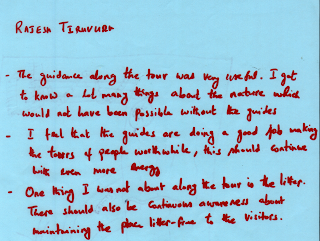On Sunday, we had our regular monthly nature walk at Chek Jawa Boardwalk. Instead of the usual huge crowds that we used to have, we had just 5 visitors this time. We wondered if the low turnout was because we asked for pre-registration and it may have deterred many people from committing to a trip. We must think harder for a solution to our problem that oscillates between having too many visitors and then too few. It is not easy to find an equilibrium!


(Fruit of the Barringtonia asiatica)
Ivan and Vyna took the only group out on the boardwalk while Anuj and I were able to explore on our own. For the first time, we started hunting for seeds near the shore. Our best find was the large fibrous fruit of the Poison Fish Tree (Barringtonia asiatica). It has a most unusual square base. Flowers are large and look like a beautiful pink and white powder puff.
We also found a Barringtonia asiatica sapling nearby. I’m going to monitor this sapling in future trips
A related species called the Barringtonia racemosa can be found in the same area. The flowers are also pink and white powder puffs but smaller in size. The pear-shaped fruits hang in a long stem of about 60 cm long. Both these Barringtonia species are pollinated by bats and moths.
We next stopped to look at the impressive Seashore Lily or Crinum Lily plant (Crinum asiaticum). It is found just next to the boardwalk near the shore.

The Seashore Lily was blooming and fruiting at the same time. We counted 35 flowers in the inflorescence. The bulbs are heavy and as a result they droop to the side and were resting on the ground. I am glad we had time to stop and take a closer look at this beautiful species.
Hey, I must add that not far from the Seashore Lily, the other group saw a pair of horseshoe crabs mating!
(Varanus salvator)
Further down the mangrove boardwalk, we spied a juvenile Malayan Water Monitor Lizard (Varanus salvator) resting on some styrofoam debris. I recounted the monitor lizard sighting to Ivan later on and lamented that the water monitor lizards in Chek Jawa are not as large and impressive as those found in Sungei Buloh. Ivan remembered that he had seen a huge adult one before. Really? That’s another animal to look out in future!

Here are more pictures of Ivan and Vyna’s group as they progressed along the route.

 The repair works on the floating pontoon were completed and we were able to walk all the way to the end of the pontoon. While on the pontoon, we were able to see a few species of fishes that thrive in the waters of Chek Jawa. I’m pretty hopeless with naming fishes but fortunately Ivan was there to point out the needle fishes, halfbeaks and gar fishes. Most of them are juveniles which kind of support the popular belief that Chek Jawa is a refuge place for juvenile fishes.
The repair works on the floating pontoon were completed and we were able to walk all the way to the end of the pontoon. While on the pontoon, we were able to see a few species of fishes that thrive in the waters of Chek Jawa. I’m pretty hopeless with naming fishes but fortunately Ivan was there to point out the needle fishes, halfbeaks and gar fishes. Most of them are juveniles which kind of support the popular belief that Chek Jawa is a refuge place for juvenile fishes.What about the birdlife in Chek Jawa? Oh yes, we first heard the loud and clear chirps (“chiup-chiup-chiup”) of the Common Tailorbird, and after trying very hard, we finally spotted it perched on the branch of the Sea Almond Tree. The Tailorbird is quite a gregarious little fellow that does make its presence felt. It is so named because it is able to ‘stitch’ leaves together to form a nest.
The Oriental Pied Hornbills were present at Chek Jawa during our walk, mostly likely feeding on the ripe rambutans that are in season now. However they teased us with their loud “ka-ka-ka” calls near the mangrove and forest areas, but would not reward us with a sighting.
The bulbuls (likely the Straw-headed Bulbul) and the kingfishers could be heard too. But not seen! Just not our day for bird-watching at Chek Jawa!
To end our day of adventure, we saw a family of wild boars near Punai Hut. Our taxi driver, Tian Song, grabbed a few small bags of biscuits from his van and threw them at one of the wild boars. The little fellow was able to tear the foil using its snout and paws, and got to the biscuits. Is this the new “Priscilla”, the hand-fed wild boar?
 As always, we end our blog with drawings and words from our visitors. To Charmaine, Cheong Kai and Beng Teck who attended our workshop at the Young ChangeMakers Conference 2009, we are delighted to have you join us on the walk. Did you get the information that you needed from the interview?
As always, we end our blog with drawings and words from our visitors. To Charmaine, Cheong Kai and Beng Teck who attended our workshop at the Young ChangeMakers Conference 2009, we are delighted to have you join us on the walk. Did you get the information that you needed from the interview?
 To Rajesh, our new friend, hope you like Chek Jawa. I agree totally with your comment about the litter in Chek Jawa. That is an “interesting” topic for another blog!
To Rajesh, our new friend, hope you like Chek Jawa. I agree totally with your comment about the litter in Chek Jawa. That is an “interesting” topic for another blog!And finally, thanks go out to Ivan, Vyna, Anuj and LK who helped this weekend.








Great observations. I grew up by the sea in Cebu, Philippines. There are many adventures we had with the sea, the fish, the tidal pools.
ReplyDeleteLIFE BY THE SEA is always an adventure - with the constant tidal movement of the water and the seaweeds.
Documenting them with your blog is a wonderful idea.
Thanks Rudy! We document the natural life that we see during our nature walks so that we have a record of the sightings. The photos are also very important. If you're visiting this part of the great pond, come visit with us at Chek Jawa. /Leykun
ReplyDelete